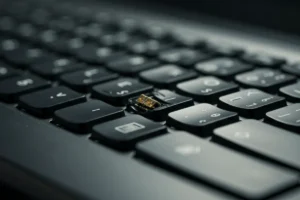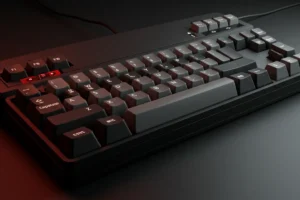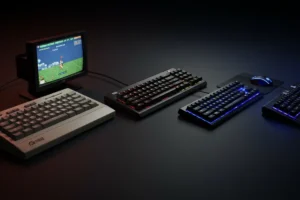So, how do you understand the impact of mechanical keyboards on esports? Let me tell you, as someone who has been an absurd fan of keyboards for years, witnessing their evolution and importance in competitive gaming has been nothing short of fascinating.
Mechanical keyboards have become the gold standard for esports players across the globe. But how did we get here? What makes these devices so integral to professional gaming?
Buckle up, because in this comprehensive article, I’ll take you on a journey through the rich history, significant milestones, and key innovations that have shaped the mechanical keyboard’s role in esports.

The Dawn of Mechanical Keyboards in Gaming 🎮
Mechanical keyboards date back to the 1980s when IBM introduced the iconic Model M. This beast of a keyboard was durable, tactile, and built like a tank—qualities that gamers eventually came to love.
Initially, gaming was more of a casual pastime, and professional esports as we know it today didn’t exist.
However, by the late 1990s and early 2000s, competitive gaming started to take off with games like Counter-Strike and StarCraft.
I remember when I first laid my hands on a Cherry MX Blue switch. That distinctive click made me feel like I was commanding an army with every keystroke.
Gamers quickly realized that mechanical switches provided faster response times, greater accuracy, and superior durability compared to membrane keyboards. These features were critical for competitive play where every millisecond counts.
By the mid-2000s, mechanical keyboards were no longer a niche product but a necessary tool for serious gamers. Companies like Razer and SteelSeries began producing mechanical keyboards tailored specifically for gaming.
If you want to learn more about choosing the best keyboard for your needs, you should check out my in-depth guide here.
Why Mechanical Keyboards Dominate Esports 🏆
1. Durability
Mechanical keyboards are known for their exceptional lifespan, often enduring 50 million keystrokes or more.
In the high-pressure environment of esports, where intense practice sessions and tournaments can wear down equipment quickly, this durability is indispensable.
2. Precision and Speed
Unlike membrane keyboards, mechanical switches provide consistent actuation force and feedback, minimizing errors during gameplay. I personally believe that the ability to customize switch types—from linear to tactile to clicky—gives players a significant edge.
3. Customization
Esports pros love to tailor their setups for maximum performance. From programmable macros to RGB lighting and adjustable actuation points, mechanical keyboards offer a level of customization that membrane keyboards simply can’t match.
For an awesome breakdown of keyboards with adjustable actuation points, don’t miss this article here.
The dominance of mechanical keyboards in esports is so profound that most major tournaments today practically standardize their use. It’s rare, if not impossible, to see a professional player using a membrane keyboard in high-stakes competitions.

Iconic Mechanical Keyboards in Esports History ⌨️
Let’s look at some of the most iconic mechanical keyboards that have defined esports over the years:
- SteelSeries Apex Pro – Known for its adjustable mechanical switches and used by many top-tier esports pros.
- Razer BlackWidow – A pioneer in gaming-specific mechanical keyboards, bringing RGB lighting and macro keys to the mainstream.
- Corsair K70 – Loved for its durability and Cherry MX switches.
- HyperX Alloy Origins – An excellent budget mechanical keyboard, check out my detailed review here.
Each of these keyboards has played a pivotal role in shaping the competitive gaming landscape.
From LAN tournaments to massive international events like The International and League of Legends World Championship, mechanical keyboards have been front and center.
The Evolution: From Clicky Switches to Silent Innovations 🤫
The history of mechanical keyboards in esports is also a story of continuous innovation. Originally, loud and clicky switches were the norm. However, as esports tournaments grew and broadcasting became standard, the demand for quieter keyboards increased.
Switch manufacturers like Cherry and Gateron responded with silent variants that maintain tactile feedback without the noise. Personally, I prefer tactile switches because they give me a satisfying bump without waking up the entire neighborhood!
This evolution mirrors the broader trend toward ergonomic design and performance optimization. Many players now choose silent or linear switches to reduce strain and increase their reaction times. If you’re curious about silent mechanical keyboards, I’ve written an insightful piece about them here.

The Role of Mechanical Keyboards in Modern Esports 🎯
Today, mechanical keyboards are considered essential hardware for any serious esports player. From FPS games like Valorant and CS:GO to MOBAs like Dota 2 and League of Legends, mechanical keyboards offer a decisive competitive advantage.
Professional organizations such as Cloud9, Team Liquid, and Fnatic all equip their players with high-end mechanical keyboards.
According to a Wikipedia article, the esports industry is now worth over a billion dollars, and much of this success is tied to the optimization of player equipment—including keyboards.
Mechanical keyboards also play a role in training and skill development. Many players use specialized training software to fine-tune their mechanics, relying on the reliability and consistency of their mechanical keyboards to accurately reflect their progress.
If you’re wondering how to optimize your keyboard for competitive gaming, I highly recommend checking out this helpful guide here.
FAQs ➡️
➤ Are membrane keyboards allowed in esports tournaments?
Yes, but they are rarely used due to their inferior performance compared to mechanical keyboards. Most professional players opt for mechanical keyboards for the edge they provide.
➤ Do professional gamers use membrane keyboards?
Almost never. Mechanical keyboards are preferred due to their durability, customization, and performance benefits.
➤ What are the best switches for esports?
It depends on personal preference, but linear switches like Cherry MX Reds and speed switches are popular due to their quick actuation.
➤ How can I improve my gaming with a mechanical keyboard?
Start by choosing a switch type that matches your playstyle and invest in a keyboard with customizable features. Also, practice regularly to get used to the tactile feedback.
See More
- The Most Annoying Keyboard Issues and How to Fix Them
- The Best Keyboards for Retro PC Builds
- The History of Mechanical Keyboards in Esports
Conclusion: The Mechanical Keyboard Legacy Continues 🚀
Reflecting on the history of mechanical keyboards in esports, it’s clear that their influence is unparalleled. As someone deeply passionate about keyboards and gaming, I can confidently say that mechanical keyboards are here to stay and will continue to evolve alongside the esports industry.
If you liked this article, don’t forget to share it with your friends and drop a comment below—let me know what keyboard you’re using right now for gaming! I’d love to hear from you.
Also, don’t miss out on exploring more of my articles over at Keyboards Technology—especially if you want to dive deeper into topics like the most responsive keyboards for competitive play or how to reduce input lag in wireless keyboards.
For additional reading on esports and gaming hardware, check out this excellent resource on Wikipedia’s Esports page.
Thanks for reading—catch you next time! 🎮👋


